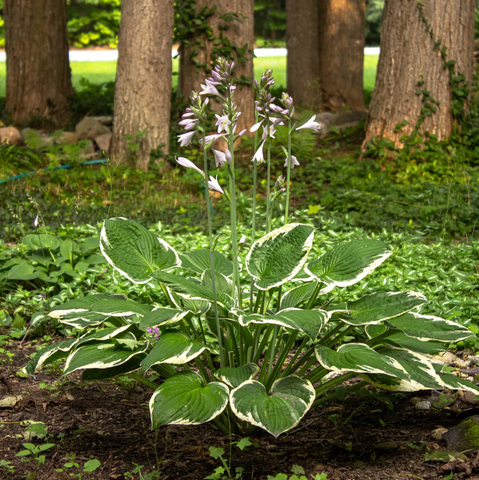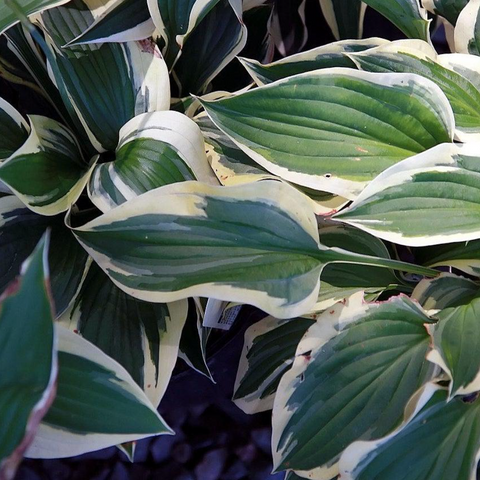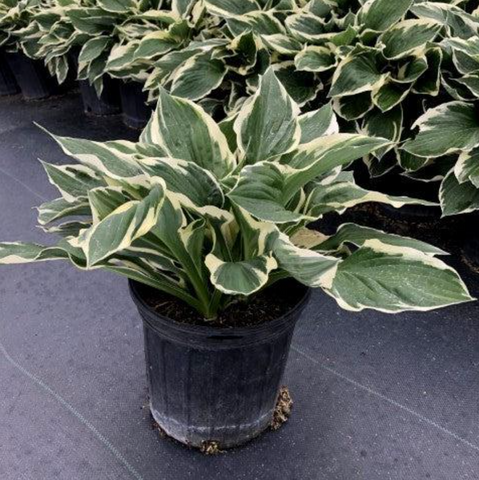A Guide to Growing Monrovia’s Patriot Hosta
If you're looking for a beautiful, easy-to-grow plant for your Georgia garden, Monrovia’s Patriot Hosta may be just what you need. This lovely foliage plant is prized for its vibrant green and white leaves, which add lushness and texture to any garden.
In this guide, we'll take a closer look at the Patriot Hosta and explore everything you need to know to grow this plant successfully.
Understanding the Patriot Hosta Plant

IMAGE: Scottb211, Patriot Hosta
The Patriot Hosta is a species of herbaceous perennial plant that belongs to the Hostaceae family. It is a clump-forming plant that typically grows in clumps 12 to 20 inches tall and 30 inches wide.
Its leaves are heart-shaped and range in color from green to green and white variegation. The plant produces lovely lavender flowers in the summer, which attract pollinators to the garden.
Characteristics of the Patriot Hosta
The Patriot Hosta is known for its striking green and white foliage, which makes it a popular choice for shady and woodland gardens. The leaves are medium to large in size and have a smooth texture with a waxy surface. The green leaves have a white margin that can be up to 1.5 inches in width, which makes them stand out in the garden. The plant's flowers are fragrant and attract bees, butterflies, and hummingbirds.
The Patriot Hosta is a hardy plant. It is resistant to most pests and diseases, making it a low-maintenance plant for your garden. The plant's foliage is also deer-resistant, which is a bonus for those who live in areas with high deer populations.
Ideal Growing Conditions for the 'Patriot' Hosta
The Patriot Hosta is a versatile plant that can tolerate a wide range of growing conditions. It prefers partial to full shade and moist, well-drained soil. While it can grow in full sun, it will need more frequent watering and may suffer from leaf scorch. In terms of climate, the plant can grow in USDA hardiness zones 4 to 8.
When planting the Patriot Hosta, it is important to choose a location that provides enough shade to protect the plant from the hot afternoon sun. The plant also benefits from regular watering, especially during dry spells. Adding a layer of mulch around the base of the plant can help retain moisture in the soil and keep the roots cool.
In terms of soil, the Patriot Hosta prefers a soil pH of 6.5 to 7.5, which is slightly acidic to neutral. If your soil is too alkaline, you can amend it with peat moss or elemental sulfur to lower the pH. The plant also benefits from soil that is rich in organic matter, such as compost or aged manure.
Popular Uses in Landscaping and Garden Design
Because of its striking foliage, the Patriot Hosta is an excellent choice for adding texture and color to shady areas of your Atlanta area garden. The plant is often used as a border plant along walkways or as an accent plant in mixed borders. It also looks lovely when planted en masse in woodland gardens or around water features.
The Patriot Hosta can also be grown in containers, making it a great choice for those with limited garden space. When planting in a container, it is important to choose a pot that is large enough to accommodate the plant's root system. The container should also have drainage holes to prevent water from accumulating in the soil and causing root rot.
Preparing the Soil for Your Patriot Hosta
Growing a beautiful and healthy Patriot Hosta requires proper soil preparation. Here are some tips to help you get started.
Soil Type and pH Requirements
The Patriot Hosta thrives in well-draining soil that is rich in organic matter. If your soil is too alkaline, you can amend it with peat moss or elemental sulfur to lower the pH and create a more hospitable environment for your plant.
Note that different soil types can affect the growth of your Patriot Hosta. For instance, sandy soils tend to drain quickly and may require more frequent watering, while clay soils tend to retain water and may require more frequent soil amendments to improve drainage.
Amending the Soil for Optimal Growth
If your soil is heavy or clay-like, you can amend it with compost, aged manure, or other organic materials to improve drainage and add nutrients. Before planting your Patriot Hosta, be sure to work the organic matter into the soil to a depth of 12 inches or more. This will give the roots of your plant plenty of room to grow and access the nutrients they need to thrive.
Organic matter also helps to improve soil structure and texture, making it easier for water and air to penetrate the soil. This, in turn, promotes healthy root growth and helps your Patriot Hosta to establish itself more quickly.
Proper Drainage and Aeration
In addition to providing your Patriot Hosta with nutrient-rich soil, it's important to ensure that the soil is well-draining and aerated. This will help to prevent water from pooling around the roots of your plant, which can lead to root rot and other fungal diseases.
If your soil is heavy or compacted, you can improve drainage and aeration by adding perlite or vermiculite. These materials help to loosen the soil and create pockets of air, which allows water to drain more freely and promotes healthy root growth.
By taking the time to properly prepare your soil, you can help your Patriot Hosta to thrive and produce beautiful foliage year after year. So roll up your sleeves and get ready to give your plant the best possible start!
Planting and Spacing Your Patriot Hosta

IMAGE: David J. Stang, Hosta Patriot 1zz, CC BY-SA 4.0
Choosing the Right Location
When choosing a location for your Patriot Hosta, look for a spot in your garden that gets partial to full shade. Hostas are shade-loving plants and will thrive in an area with filtered sunlight.
They are commonly planted under trees or near shrubs to provide additional shade. Avoid planting the Patriot Hosta in a location that receives direct sunlight for more than a few hours each day, as this can cause leaf scorch and damage to the plant.
It's also important to consider the soil when choosing a location for your Patriot Hosta. They prefer a well-draining soil that is rich in organic matter. If your soil is heavy or clay-like, consider amending it with compost or peat moss to improve drainage and fertility.
Planting Depth and Spacing Guidelines
Once you have chosen the right location, it's time to plant your Patriot Hosta. Dig a hole that is twice as wide and just as deep as the plant's root ball. This will give the roots plenty of room to grow and establish themselves in the soil.
When planting multiple Patriot Hosta plants, it's important to space them properly to allow for adequate air circulation and to prevent overcrowding. For optimal growth, space your Patriot Hosta plants 18 to 24 inches apart. This will give them enough room to grow and spread out without competing with each other for nutrients and water.
Dividing and Transplanting Mature Plants
The Patriot Hosta is a slow-growing plant that can take several years to reach its maximum size. However, once it reaches maturity, it can become quite crowded and need dividing. Dividing your Patriot Hosta plants every few years will help to rejuvenate them and promote healthy growth.
The best time to divide and transplant your Patriot Hosta is in the spring or fall when the soil is cool and moist. Use a sharp, sterile knife to cut the plant into sections, making sure each section has a healthy root system. Replant the sections in your garden, spacing them 18 to 24 inches apart.
Keep your newly transplanted Patriot Hosta plants well-watered during the first few weeks after transplanting to help them establish themselves in their new location. Adding a layer of mulch around the base of the plant can also help to retain moisture and prevent weeds from growing.
Caring for Your Patriot Hosta
Watering and Fertilizing Requirements
The Patriot Hosta prefers moist, well-drained soil and needs to be watered regularly to thrive. Water the plant deeply once a week, making sure the soil is moist but not waterlogged.
In terms of fertilization, the Patriot Hosta benefits from an application of balanced fertilizer in the spring and early summer. Use a slow-release fertilizer that is high in nitrogen.
Pruning and Deadheading Tips
The Patriot Hosta does not require much pruning but can benefit from the removal of dead or damaged leaves. If the plant's flowers begin to fade, you can remove them to encourage the plant to focus on foliage growth instead of seed production.
Pest and Disease Management
While the Patriot Hosta is a relatively low-maintenance plant, it can be susceptible to certain pests and diseases. Japanese beetles, slugs, and snails are common pests that can damage the plant's leaves.
To manage these pests, use organic methods such as handpicking or neem oil spray. In terms of diseases, the Patriot Hosta can be susceptible to fungal infections such as powdery mildew or crown rot. To prevent these diseases, be sure to provide the plant with well-draining soil and avoid overwatering.
Final Thoughts
Monrovia’s Patriot Hosta is a beautiful, easy-to-grow plant that can add texture and color to any Georgia garden. By following the tips and guidelines outlined in this guide, you can successfully grow and care for your Patriot Hosta and watch it thrive in your garden for years to come.

Click here if you’d like to purchase this plant.
If you need any advice or tricks/tips in creating the garden of your dreams, we are here to make those dreams come true! Connect with us here, or chat with us via the chat button on the bottom of any page on our website.
To create a landscape that gives you joy every time you walk out your door or look out your window, it’s important to have a design plan in place. Learn more about our elite Designer Marketplace platform, which allows you to select easily from a list of expert landscape designers, landscape architects, and more.
Click here to view more plants from the beautiful Monrovia® collection.













































